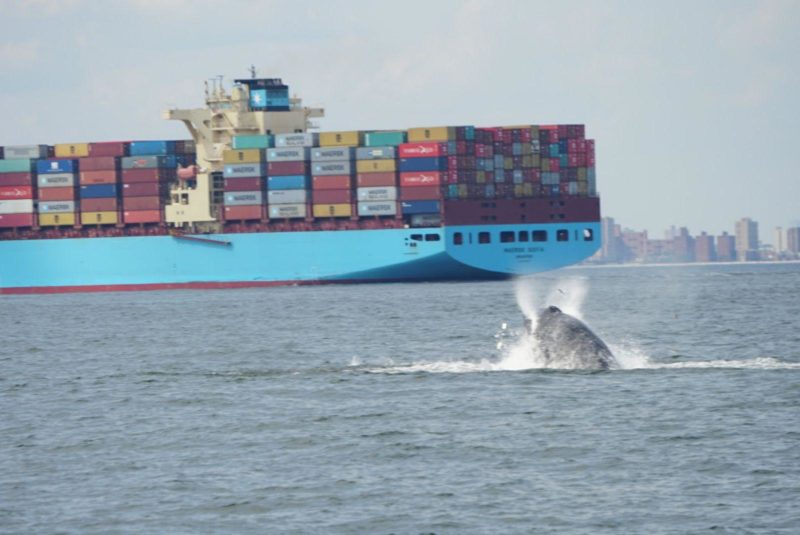Humpback whales are seen much more often around the approaches to New York Harbor, and with them come the potential for more deadly encounters with vessels, according to a new study.
“Whales feed in close proximity to the entrance of the Port of New York and New Jersey, creating potentially dangerous situations for both vessels and whales. Documenting humpback whale presence and identifying the risks are crucial for both short- and long-term management,” wrote researchers at George Mason University in Virginia and Gotham Whale, a nonprofit group in New York City.
Published in the journal Marine Policy, authors Danielle M. Brown, Paul L. Sieswerda and E.C.M. Parsons report humpback whale sightings – along with strandings of dead whales – have substantially increased around the apex of the New York Bight since 2011. The team makes a case for stepping up whale monitoring in the Bight, for both conservation and the safety of mariners and whales.

A humpback whale and vessels near New York. Tugs and tows travel at lower speeds but can still be at risk of collision with whales feeding close to shore, according to a new study. Photo by Celia Ackerman/Gotham Whale
“What I found was there was a significant increase over time, with a very significant increase in 2014,” said Brown, a former technician with the Marine Mammal Stranding Center, Brigantine, N.J., and an associate researcher with Gotham Whale now pursuing a doctorate degree at Rutgers University.
“We need to account for them on a much more regular basis,” said Brown. “It’s important to educate everybody about what to do when whales are in the area.”
Co-author Paul Sieswerda is director of Gotham Whale, which solicits detailed whale sighting reports from boaters, kayakers, fishermen and passengers on the 95' whale watch vessel American Princess, based at Queens, N.Y., and operated by TWFM Ferry Services Inc.
Some 45% of sightings recorded by Gotham Whale were less than 3 kilometers (1.8 miles) from shore, and analysis of automatic identification system data from passing vessel traffic showed that in 2016, 95% of sightings were within 100 meters (328') of at least one vessel transit.
Those close encounters can be deadly. From 2015 through 2018 there were 85 documented humpback strandings from Maine to Florida, said Brown. In 2017 the National Oceanic and Atmospheric Administration declared the losses to be an “unusual mortality event” and the agency continues to keep a close eye on the species.
“Only about 50% show signs of vessel strikes,” but many carcasses are so decomposed by the time they wash up that necropsies cannot reveal an exact cause of death, said Brown. Entanglement in fishing gear is another cause of whale mortality, and NOAA and the Northeast lobster industry are under intense pressure to reduce those losses.

Excursion boat passengers can see humpback whales feeding in New York Harbor. New York Media Boat photo via Twitter
Marine scientists and fishermen say the whales are attracted by menhaden — oily, herring-like fish that are a mainstay of their diet that move in big schools through the bight. Decades of better pollution control and cleaning up the harbor estuary have helped too.
“Something is definitely drawing humpback whales to this area, and we think its prey availability,” said Brown, referring to the menhaden. Whale sightings in the lower and upper harbor, and New Jersey’s Raritan Bay, suggest the animals may be using the deep water in dredged shipping channels to forage, the authors noted.
The Gotham Whale study “does not include the impact of recreational vessels” because most of that fleet does not carry AIS, said Brown. “I think that needs to be studied more.”
The study mapped whale sightings and overlaid AIS tracks recorded at the same time to find where whales were seen close to shipping. The highest encounter potential was with passenger vessels, including the harbor’s busy ferry industry, followed by tug and tow vessels.
“The smaller size of tug/tow vessels enables them to travel outside of dredged shipping channels and closer to shore, where a large number of humpback whale sightings were located,” the authors wrote. Because tugs and tows move at lower speeds than other vessels, there’s less chance of mortally injuring a whale, but the collision potential is still there, they say.
The report’s passenger vessel category includes all ships certified to carry 150 passengers or more, including cruise ships and ferries.
“Passenger vessels are known sources of whale mortality and cruise ships occasionally return to port with deceased whales on their bulbous bows,” the report notes. “There are three major cruise terminals in the Port of New York and New Jersey, with some of the largest ships in the world transiting New York Harbor weekly during high season. Ferries have also been implicated in whale-vessel collisions, and there are numerous commuter ferries, including high-speed ferries, that make multiple transits daily through the study area.”
Where shipping lanes converge outside New York Harbor, NOAA calls for vessel speed restrictions to protect the highly endangered northern right whale during its migration season from Nov. 1 through April 30.
But there are no speed restrictions at the height of the humpback whale season, which has been beginning earlier in May and runs through the summer and fall, said Brown.
Unlike right whales, humpbacks are not listed as endangered, “but that doesn’t mean we should put them back on the endangered list,” she said.
“Recreational vessels have been implicated in collisions with whales, and numerous close encounters have been documented” in the New York Bight region, with the danger of serious injuries for both boaters and whales, the report says. The authors call for more educational outreach to the maritime community and boaters, and more formal research into the population size and distribution of humpback whales in the New York Bight.




